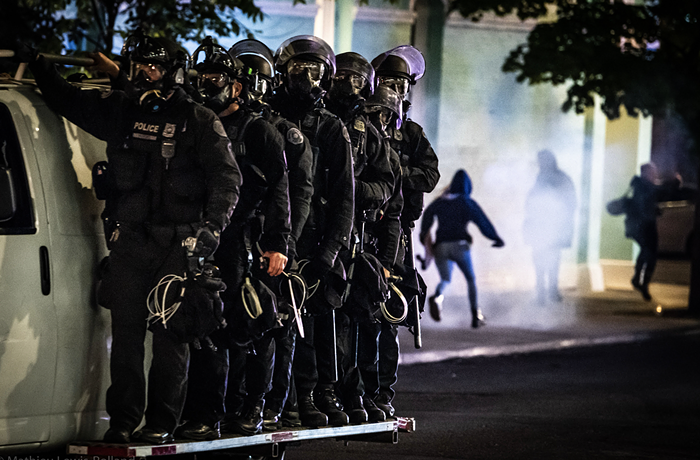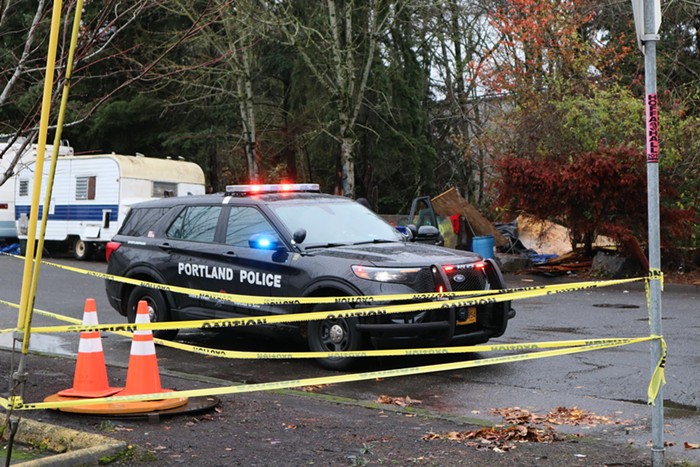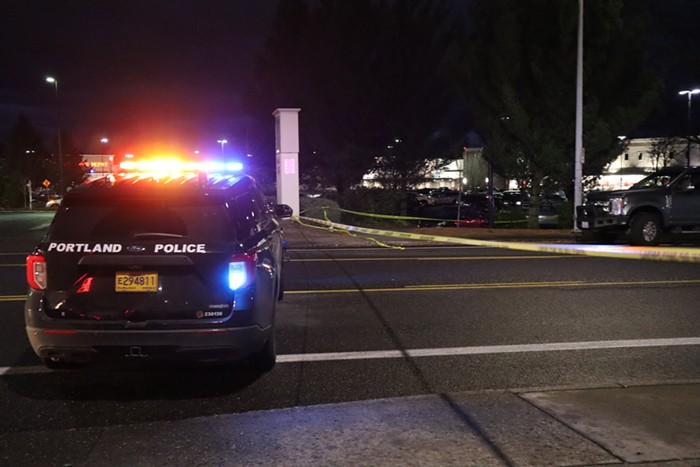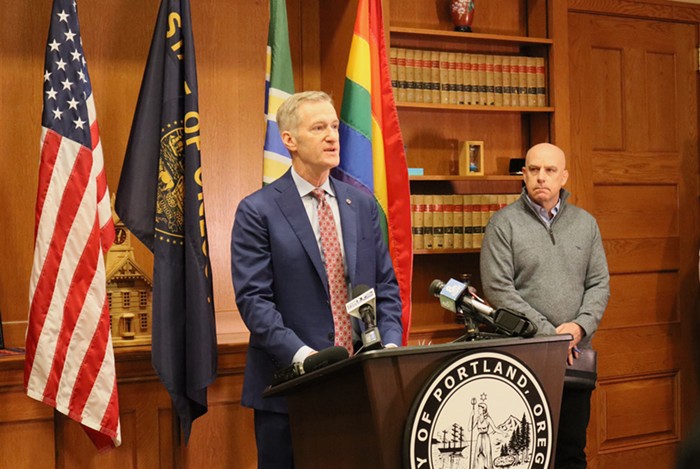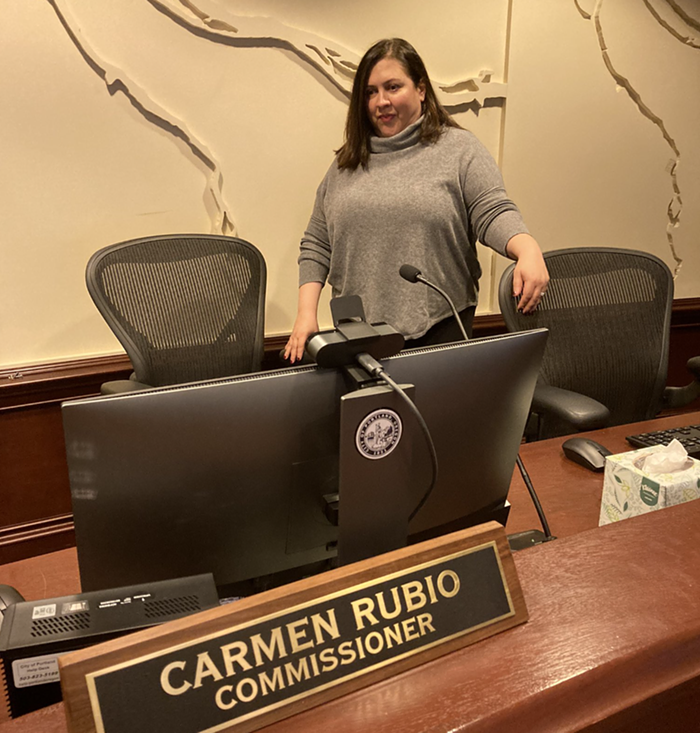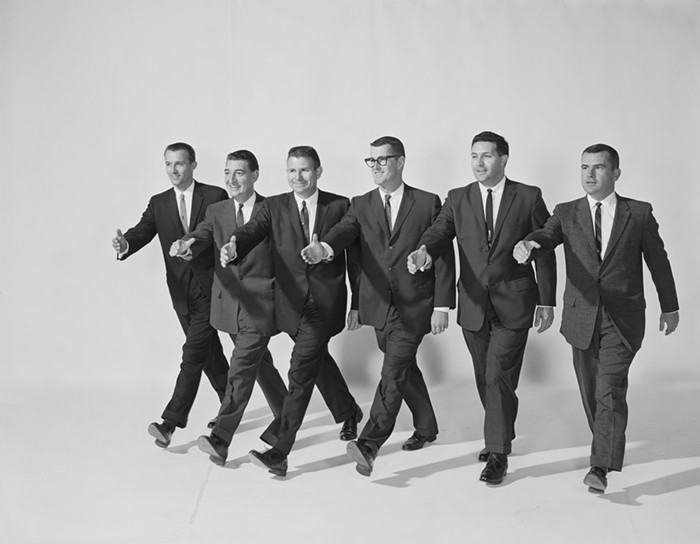
- Denis C. Theriault
- Mayor Charlie Hales, Chief Mike Reese, and Assistant Chief Donna Henderson.
But Hatch never got any closer than 40 or so feet, falling to the ground when those three officers unloaded their weapons into him outside Adventist Medical Center on Sunday night.
Portland police still won't say how many shots were fired, what Hatch was doing in Adventist's emergency room, or whether the cops who shot Hatch had even thought about using less-lethal weapons to subdue a man who kept calling them from behind an SUV to "come on" and "come play." Those things will wait for a yet-to-be scheduled grand jury hearing.
But the bureau, in a carefully programmed press conference, did release a subtitled cell phone video, police radio audio (mp3), and surveillance camera stills to begin to fill in the picture of a death that happened just 12 minutes after the first calls came to East Precinct.
"They intentionally kept their distance," Police Chief Mike Reese, flanked at one point by Mayor Charlie Hales and newly promoted Assistant Chief Donna Henderson, said of the cops who shot Hatch. "The situation unfolded very quickly."

- Portland Police Bureau
- The busted phone receiver...
The total impression left by the bureau's materials, without knowing why Hatch was hospitalized, is pretty much going to be "suicide by cop." The cops for the first time said a security guard at Adventist did see a black object that appeared to be a gun. And the police audio repeatedly describes Hatch's phone handle as a "weapon" and "gun," even warning after he collapsed that "the weapon is just a few inches from his right hand."
"Detectives believe the suspect used this to simulate a handgun... during this incident with Portland police officers," Reese said.
Henderson said the video, taken by someone leaning out his window across the street from the hospital, "was very critical. It was a very good video." It played while Reese lightly narrated it. Hatch can be heard shouting various incendiary things at the cops he's spotted: "Come on." "I'm gonna take hostages, motherfucker. You stupid motherfucker." "You're making it fucking hard for me and you." "You want some? You wanna play? Come on." "You and that dog are killing people tonight. I can guarantee that. That's a promise."
Then, before he runs toward the officers, he can be heard shouting: "Okay. I'm gonna come to you. I'm coming to you, pig. Let's go. Let's go." As he raced closer, the officers didn't apparently budge. And Hatch started counting up, "ONE"... as the cops shouted "Stop."... then "TWO"... "Hands up!"... then "THREE" and a loud burst of gunfire followed by one stray shot at the very end. The autopsy results show, unsurprisingly, that Hatch died of multiple gunshot wounds.
(Watch the video after the jump, but be warned, if these kinds of things are hard to watch for you, that it's extremely upsetting and violent.)
Henderson wouldn't comment on what the video meant to her when she saw it, other than that it was valuable for investigators. She also wouldn't say whether officers actually saw the black object in his hand or whether he aimed it aggressively as he sprinted toward them.
"Everybody's going to have their own interpretation," she said of the video, "and I don't want to taint any grand jury process that's going to happen."
The bureau also says it could find no history of mental illness for Hatch. But it argued that medical privacy laws prevent it from saying why he was at Adventist or exactly how long he'd been there (less than a day). It wasn't mentioned whether the hospital had figured out he was a fugitive or not. But it did release more information about Hatch's record, reminding us that he was a federal fugitive sought by Marshals. And it tied him to two recent bank robberies in the days before his death, one in Clackamas the other on NE Sandy.
The bureau waited days to confirm Hatch wasn't armed and had a "simulated" weapon, in part because that's how long it says it took to get the cops involved—Sergeant Nathan Voeller (12 years with the bureau), Officer Andrew Hearst (three years), and Officer Royce Curtiss (seven years)—to agree to interviews. Never mind that in other shootings, it released that information within hours.
(For the record: Voeller, a defensive tactics instructor and an early recipient of crisis intervention training, was one of the cops who shot David Earl Hughes in 2006. Voeller also was prepared to publicly back Ron Frashour, the cop fired over the fatal 2010 shooting of Aaron Campbell. If a civil trial in the Campbell case had gone forward, Voeller would have testified that cops don't need to see a gun [Campbell was unarmed] if they think someone's going to shoot them.)
But video and audio this early in an investigation are, on the other hand, quite rare. So is a press conference in front of TV cameras and radio microphones and most of the city's newspaper hacks.
Hales promised accurate and timely and consistent information when he spoke, setting the tone for the event. His chief of staff, Gail Shibley, was in the room along with Baruti Artharee, his public safety director. Clay Neal, who served as Sam Adams' public safety liaison and is now working directly for the bureau on issues related to the federal investigation of the bureau's use of force, also was in attendance.
Portland Police Association President Daryl Turner was seen talking to Assistant Chief Eric Hendricks before the event started.
"Those larger questions obviously are for a later day," Hales said about the use of force in this case and others. But that "I and my team have been fully engaged and kept fully informed by the bureau."
Here's the bureau's full statement, for the record:
Today, Wednesday February 20, 2013, the Portland Police Bureau is releasing additional information about Sunday evening's officer-involved shooting at Portland Adventist Medical Center (PAMC).
Investigators recovered a black piece of plastic near the body of the suspect, 50-year-old Merle Mikal Hatch. This black piece of plastic is approximately eight inches long and two inches wide. Detectives believe that the suspect used this piece of plastic to simulate a handgun when he encountered hospital security at two different times and, later, Portland Police officers.
During the course of the investigation, detectives believe that the suspect stole a telephone receiver handle from the hospital and then broke it in half to simulate a handgun.
A photo of this piece of evidence is being released to the public as well as an undamaged phone handle taken by detectives for comparison.
Detectives have not recovered a handgun and at this time, do not believe that the suspect ever possessed a handgun during this encounter.
An area resident who had his window open heard some noise outside and captured video of the suspect prior to the shooting, including the suspect's actions leading up to and including the shooting.
This video, which mainly features audio of the subject, is being released to the public. Please note that its audio is graphic.
Additionally, detectives are releasing the audio recording of the dispatched call and subsequent radio traffic leading up to and including the officer-involved shooting.
During the incident officers responded to the parking lot where the suspect was located. The suspect continued to challenge the officers and refuse commands. The officers intentionally kept their distance, while they were waiting for additional resources. However, during the course of the encounter, the suspect charged at the officers, running 65 yards toward them. The officers deployed lethal force from 14 yards away.
Following the shooting this week, Portland Police Bureau Robbery detectives have determined that Hatch was involved in a bank robbery last week in Northeast Portland. The robbery occurred on Wednesday February 13, 2013, at 2:41 p.m., at the Albina Community Bank, located at 5636 Northeast Sandy Boulevard. In the robbery, the suspect, later identified as Merle Hatch, used a demand note to obtain an undisclosed amount of money from the bank. Surveillance photos from this robbery are also being released today as well.
At this time, all involved and witness officers have been interviewed by the Portland Police Bureau. However, because all of these officers and other witnesses will be testifying at Grand Jury, we cannot release any additional details at this time.
This remains an ongoing officer-involved shooting investigation and the Portland Police Bureau is committed to releasing as much information as possible in a timely manner. The three pieces of evidence being released today are being shared with the consent of investigators and the District Attorney's Office. It's important to understand that during any investigation, there are things that cannot be shared prior to all interviews being completed.
The Police Bureau did not release specific information about the recovery of the piece of plastic or the lack of recovery of a gun earlier than today, because it could have affected the integrity of witness interviews. Generally, evidence like this can't be shared until after detectives have an opportunity to conduct most, if not all, interviews. Though the Bureau's goal is to be completely transparent in regard to officer-involved shootings, the Bureau's first priority is to complete a thorough investigation to be presented to the District Attorney's Office.
At the completion of the investigation, the case file will be given to the Multnomah County District Attorney's Office for presentation to a Grand Jury. The three involved Bureau members will remain on standard paid administrative leave until the completion of the Grand Jury.
Following the Grand Jury, the Bureau will release additional information as is standard practice. Additionally, as part of the use of force review process, the Bureau will conduct an internal review of the entire incident and the case will go before the Bureau's Use of Force Review Board (UFRB).
